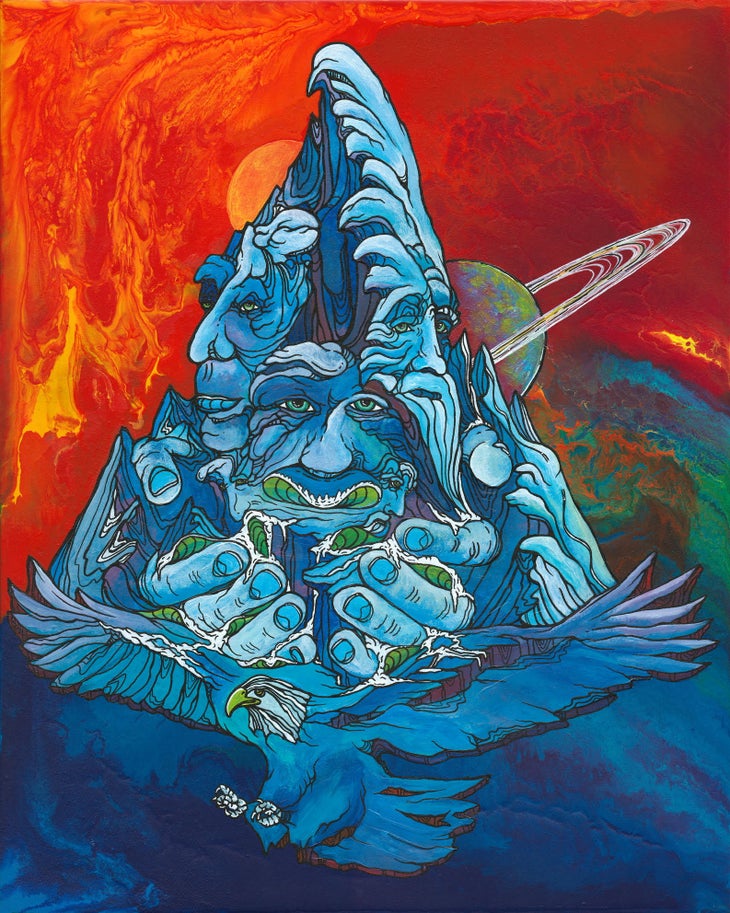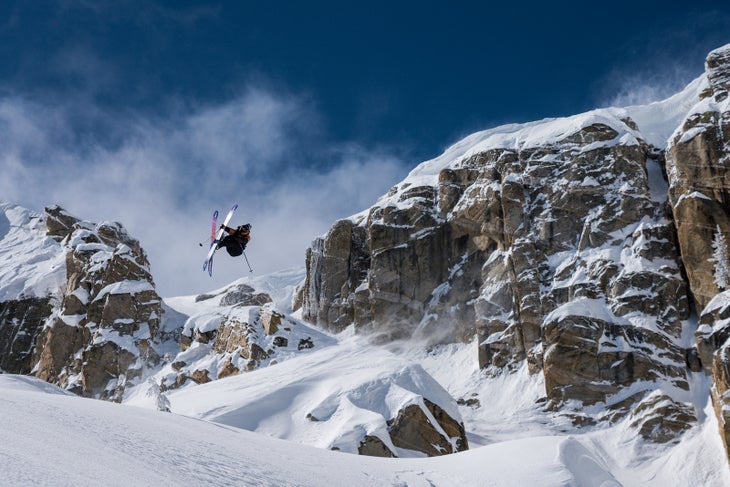Products You May Like
Get full access to Outside Learn, our online education hub featuring in-depth fitness, nutrition, and adventure courses and more than 2,000 instructional videos when you sign up for Outside+
Sign up for Outside+ today.
If you listened closely when Shane McConkey strapped a pair of 170 millimeter-wide water skis to his feet and made a few gorgeous, slarved turns down a massive powder-choked face in Bella Coola, BC, you could hear the muffled cries of dozens of grumpy old skiers moaning, “That’s cheating.” Nothing polarizes a community like new technology.
So goes the discourse surrounding web3, a shorthand for the myriad of technologies surrounding the blockchain and cryptocurrencies—the most hotly debated of which is the NFT, or non-fungible token. But before your gut has your index finger sprinting toward the back button, know this: skiers and creatives are diving into this community of artists, developers, and engineers and it has much more to offer than a new way to launder money.
In order to find out more about the intersection of NFTs and the ski community, we spoke to Chris Benchetler, the artist, skier, and newly minted creative director of freeskiing at Atomic. Benchetler’s work has not only been featured on 15 years of Atomic top sheets, but on vans, murals, and in films. Recently, he explored a new medium when he sold a piece of digital art as an NFT for 8 Ether—roughly $25,000—or the equivalent of ½ the average annual salary of most professional skiers.

You can think of NFTs, or non-fungible tokens as digital playing cards. Dollars, or Bitcoins, are fungible, or replaceable. It doesn’t matter which dollar you own. But your Henrik Harlaut trading card isn’t the same as my Tanner Hall one—that’s not a one-for-one swap.
Sure, while you can right-click and download the Jpeg that digital artist Beeple sold last year for $69 million, you can’t resell it yourself for more money. That’s where the actual technology comes in. The creation and sale of an NFT are logged on the blockchain, an immutable ledger that keeps track of every single transaction that has ever transpired on a given cryptocurrency network. This means that the ownership of these pieces of digital art is public for anyone to see. Just like you can’t walk into Christy’s and put up for sale the Monet print you got at the college bookstore, the origin of an NFT is easily verifiable.
Why should skiers care about any of this? Well, for one, it’s a medium for our favorite photographers and artists to reach new audiences and eke out a living in an industry that’s anything but lucrative. And for another, it allows them to protect and earn continued royalties through programmable smart contracts.
When a creator mints an NFT, they have leeway to insert code into the contract that will execute in the event of a future sale. So if the person that bought Benchetler’s piece decides to flip it in the future for potential beaucoup bucks, Chris will earn a percentage of the proceeds each time his piece is sold.
We wanted to know a little more about Benchetler’s ideas going into this project, so we connected with him to ask a few questions.
SKI: Where did you first hear about the web3/crypto space in general—and NFTs in particular?
Benchetler: I had a few artist friends who were considering dropping in and asked me if I knew anything, or was interested, and I had a few friends of friends that had already started to dabble. So I started doing some homework, listening to podcasts, and trying to educate myself for about a year before I finally joined the community.

What drew you, as an artist, to this kind of marketplace?
The fact that it was a community of artists supporting other artists. I personally love the idea of painting an actual canvas and owning a tangible object, but I was very open-minded to the idea that our world is always evolving, becoming more and more digital, and people will start collecting digital assets to simplify their life. Smaller apartments, more travel-oriented people that still appreciate and want to collect art. For example, when I started skiing, all my footage was shot on 16mm film. You could only buy VHS and then eventually DVDs. I saw a huge shift with cinematographers and photographers switching to digital, and then ultimately releasing all of our videos on the web. I saw some of the creatives resist digital, but ultimately everyone I was surrounded by came around and embraced technology, so I wanted to treat this space the same.
Walk me through Paradisal Transcendence, it’s a complicated piece of digital art. Did you create the whole piece digitally or paint it and then create the movement digitally?
It was rather complicated. It is hand-painted, acrylic on canvas, and then animated by my friends at Morf Studios in the UK, who animated my art for the film “Fire On The Mountain.” It represents our ski community, the mountains, and the souls we’ve lost to them. After the Tordrillo Heli crash, where five out of six skiers died, I painted it as a tribute to them as well as my mentors and donated the original painting to Greg Harms’ partner and their infant daughter who were left behind.
How deep are you into the crypto sphere? On which currency network did you mint Paradisal Transcendence?
I’m not super deep. Still trying to walk before I run and learn as much as possible. My genesis piece was minted on ETH.
Did anything draw you to choose SuperRare as your preferred marketplace over a more diffuse market like OpenSea?
Yes, the idea of establishing myself as an artist in the space by only offering a one-of-one [unique] art piece, since that’s how I’ve operated with my current collectors outside of web3. Creating editions and utilizing a larger marketplace still intrigues me, but I want to take it slow and stay with one-of-one art for a bit, and SuperRare is a very well-respected place to do so.
Did you build any smart contract features into Paradisal Transcendence? Do you retain royalties if Artifactction2 (the buyer) decides to sell the piece for a profit?
SuperRare has the smart contract built into their minting process. And yes, I retain royalties, which is another cool aspect of NFTs and the continual support of artists.
Do you see the future of art in skiing as tied to web3? How do you see more athletes, photographers, and artists getting on board?
There is a definite future here or I wouldn’t have joined the space. It’s hard for me to fully comprehend the scale, and I’m sure many others do the same, but digital assets are becoming more and more a way of life, and just seeing where the internet has gone in the last couple decades, I can only assume that web3 has a bright future.
You’re the newly minted creative director of freeskiing at Atomic. How do you see ski brands entering the web3 sphere?
It’s been a very cool evolution and journey with Atomic. I definitely see potential. I can’t say that I know what that would look like exactly, or how these brands would get involved, but the utility aspect and the community of the NFT space is a great thing to look into. I’ve had art on skis for nearly 15 years, so I think there is definitely something cool and creative to be done there.
What’s next for you in this space?
[It’s] just the beginning. I’m trying to walk into the space and not run so I can treat the space respectfully and continue to learn and grow.
